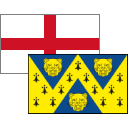
Ironbridge
Nov 2014
>
 Nov 2014+
Nov 2014+

iron say + bridge what you see! Population - 2,500.
 UK
>
England
>
Shropshire
UK
>
England
>
Shropshire
Nov 2014+

Although some people call this place home, it's really a sprawling UNESCO™ World Heritage Site with industrially themed attractions covering pipe, iron, china and everybody's favourite, the good old tile. Oh! Don't forget the teddy bears.
That means most people are here for the day but they're not exploited by the parking and a fairly priced couple of hours is more than enough for the main attraction...
What could that possibly be?
Sat on the River Severn, the place is sold as the birthplace of the Industrial Revolution. Quite a few others make that claim but there's no doubting the higher-than-average number of men who were handy with a smelter back in the day.
A pair of power stations nearby. Ironbridge A has long since gone the way and Ironbridge B will soon no longer be, eventually resting in pieces by 2023. With or without the cooling towers in view, the town retains an industrial vibe.


As for the view of the cooling towers, that will be definitely without, these days, it seems they came down in December 2019.
There are more museums here than you can shake an iron pipe at. If all things old and industrial genuinely get you excited, the best bet looks to be a year's membership for the day. These can be bought at any of the 10 main attractions but, saying that, everybody arranges everything online these days, right zedders?
There's no point trying to delay the inevitable so here's the bridge that named that toon... Ironbridge!... 'Say what you see!'


The world's first arch bridge to be cast in iron!... 'It's good but it's not quite right!' WHAT?
There's a theory that the prototype was made in nearby Highley so Highley stakes that claim, unlikely. Nonsense or not, this one is known worldwide and was built to simply showcase the nearby village of Coalbrookdale's smelting prowess.
Top-notch coffee and cake with a selection of local artwork for sale and all rated highly by advising trippers but closed on Mondays and Tuesdays.
The name is a colloquialism from the States that means to get rid of something as in... 'Hey buddy, don't 86 that annual membership to the museums'. You never know, there might be another visit later in the year despite it being a 220-mile drive.
Nothing, as was thought, to do with Thomas Telford even though he was a very busy boy in these parts. Local iron-man Abraham Darby and the architect Thomas Pritchard engineered all of this.

It was a fiddly job and took eight years from conception to being able to carry a carriage and after its completion, Telford mocked its over-engineering.
When Thomas Telford died he had a town named after him but when Darby died he didn't.
The architect Pritchard actually died just before construction was due to start. After some tweaking, it finally opened to traffic in 1781 and, well, it's nowhere near as big as it looks on Countryfile.
Tired of the industry? Take yourself over the bridge and off on the river and woodland trails.